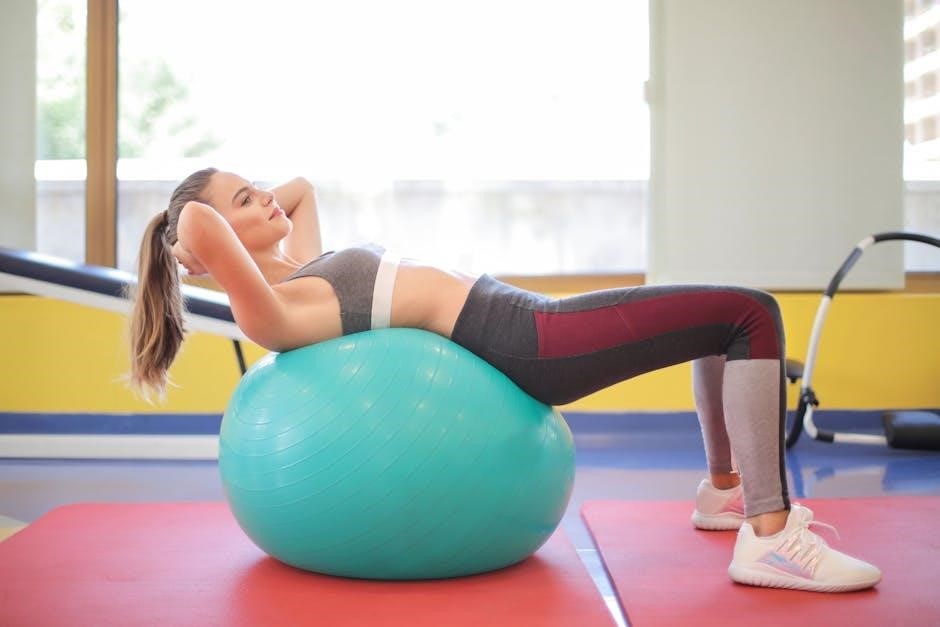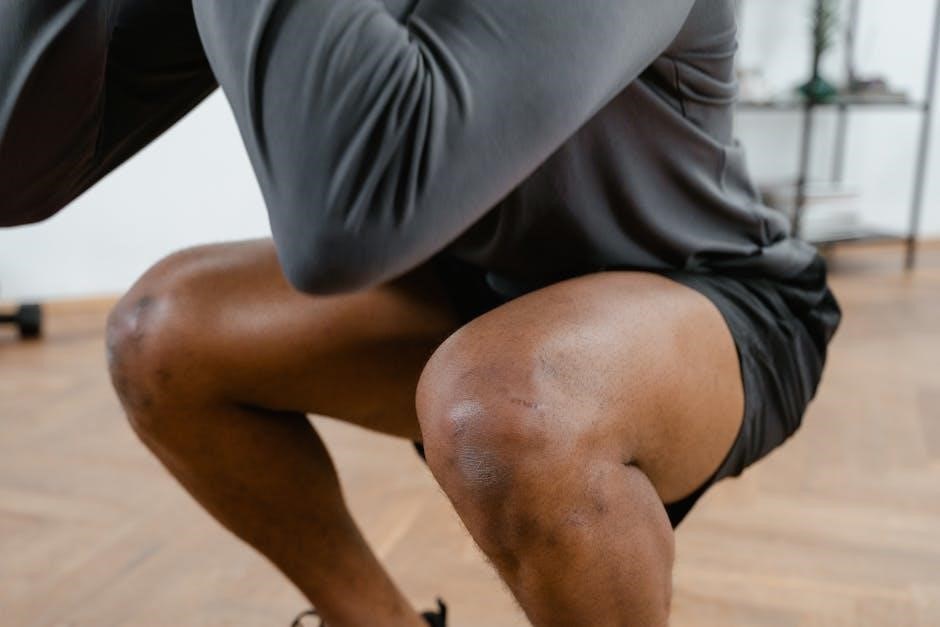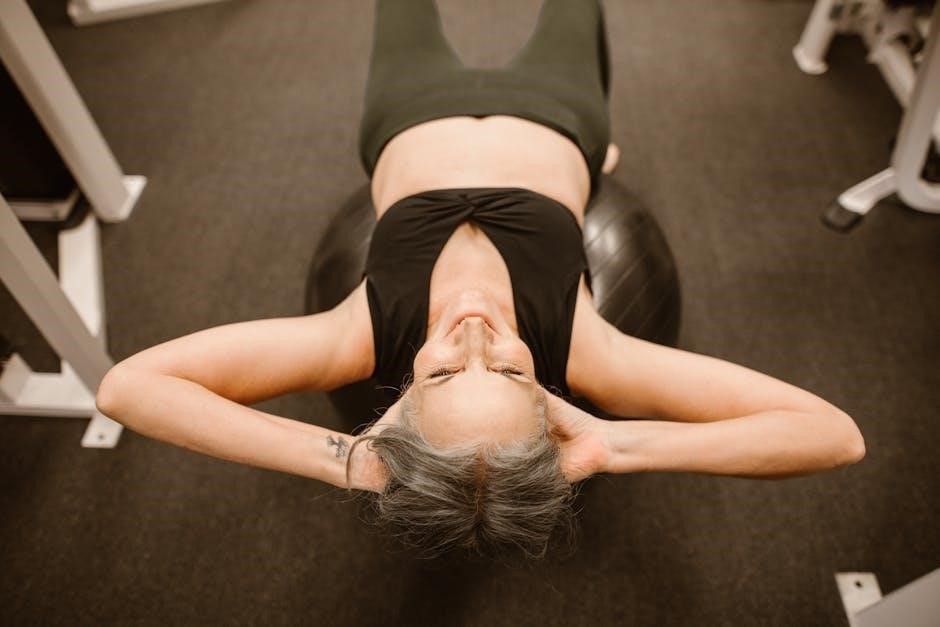
Scapular stabilization refers to exercises targeting the muscles around the shoulder blades to enhance stability and strength. These exercises, such as isometric holds and dynamic movements, are crucial for improving shoulder function and preventing injuries. Regular practice promotes proper shoulder mechanics and reduces pain, making them essential for both rehabilitation and athletic performance.
1.1 Importance of Scapular Stabilization in Shoulder Health
Scapular stabilization is vital for maintaining proper shoulder mechanics and preventing injuries. It enhances the ability of the shoulder blades to move efficiently, reducing strain on the rotator cuff and surrounding muscles. Studies show that scapular stabilization exercises alleviate pain and improve shoulder function, making them essential for both rehabilitation and injury prevention. Strong scapular stability promotes better posture, reduces wear and tear on the shoulder joint, and ensures optimal movement patterns for daily activities and sports performance.
1.2 Brief Overview of Scapular Stabilization Exercises
Scapular stabilization exercises focus on strengthening the muscles that control shoulder blade movement. They include isometric holds, such as the scapular hold, and dynamic movements like wall slides and bird dogs. These exercises aim to improve posture, reduce shoulder pain, and enhance overall shoulder function. Many routines begin with basic isometric exercises before progressing to weighted or resistance-based movements. Proper form and controlled movements are emphasized to ensure effectiveness and prevent injury, making these exercises suitable for both rehabilitation and athletic training.
Anatomy of the Scapula and Surrounding Muscles
The scapula, or shoulder blade, is supported by muscles like the rotator cuff, trapezius, rhomboids, levator scapulae, and serratus anterior. These muscles stabilize and move the scapula, enabling proper shoulder function and movement.
2.1 Key Muscles Involved in Scapular Stabilization
The primary muscles involved in scapular stabilization include the rotator cuff (supraspinatus, infraspinatus, teres minor, and subscapularis), trapezius, rhomboids, levator scapulae, and serratus anterior. These muscles work synergistically to stabilize, retract, and rotate the scapula, ensuring proper shoulder mechanics. The serratus anterior is particularly crucial for scapular protraction and upward rotation, while the trapezius assists in elevation and depression. Weakness or imbalance in these muscles can lead to poor scapular positioning and shoulder dysfunction, emphasizing their importance in stabilization exercises.
2.2 Understanding the Role of the Scapula in Shoulder Movement
The scapula plays a pivotal role in shoulder movement by serving as the base for the glenohumeral joint. It facilitates movements such as abduction, rotation, and elevation, enabling the arm to function effectively. Proper scapular movement ensures efficient shoulder mechanics, while dysfunction can lead to poor posture or injury. The scapula’s ability to rotate, tilt, and stabilize during arm movements is essential for maintaining optimal shoulder health and performance.

Benefits of Scapular Stabilization Exercises
Scapular stabilization exercises enhance shoulder function, reduce pain, and improve posture. They strengthen surrounding muscles, preventing injuries and boosting athletic performance, essential for overall shoulder health.
3.1 Improving Shoulder Function and Reducing Pain
Scapular stabilization exercises are highly effective in improving shoulder function and reducing pain. By strengthening the muscles around the scapula, these exercises enhance joint stability and proper mechanics. Isometric holds, such as scapular squeezes, and dynamic movements, like shoulder blade slides, target key stabilizers. Regular practice can alleviate discomfort from conditions like rotator cuff strains or poor posture. Starting with basic exercises, such as the pendulum stretch, helps restore mobility and strength, laying the foundation for more advanced movements. Proper form is crucial to avoid exacerbating injuries and ensure optimal benefits.
3.2 Enhancing Athletic Performance and Preventing Injuries
Scapular stabilization exercises significantly enhance athletic performance by improving shoulder stability and strength, which are critical for sports involving overhead movements or heavy lifting. Strengthening the scapular muscles helps prevent injuries such as rotator cuff strains or shoulder impingements. Isometric exercises like the scapular hold and dynamic movements like the wall slide are particularly effective. These exercises promote proper shoulder mechanics, reducing the risk of overuse injuries and enhancing overall athletic efficiency. Incorporating these into training routines can lead to better performance and long-term injury prevention.

Types of Scapular Stabilization Exercises
Scapular stabilization exercises include isometric holds, dynamic movements, and resistance-based workouts. These exercises target specific muscles to improve stability, strength, and proper scapular positioning during movement.
4.1 Isometric Exercises for Scapular Stability
Isometric exercises, such as scapular holds and wall slides, are effective for building stability without movement. These exercises involve contracting muscles while keeping the scapula still, enhancing control and endurance. They are often recommended as a starting point for individuals with shoulder injuries or instability, as they strengthen the muscles without putting excessive strain on the joint. Regular practice improves posture and reduces the risk of shoulder-related pain and injuries.
4.2 Dynamic Exercises for Scapular Strengthening
Dynamic exercises, such as arm slides, shoulder rotations, and bird dogs, involve controlled movements to strengthen scapular muscles. These exercises improve mobility, strength, and coordination. They are particularly beneficial for enhancing athletic performance and preventing injuries. Examples include wall slides to promote proper scapular movement and resistance band exercises to target stabilizers. Progressing to weighted movements, like dumbbell rows, further challenges the muscles. Dynamic exercises should be performed with focus on control to maximize effectiveness and safety.
Incorporating Scapular Stabilization into Your Workout Routine
Start with isometric exercises like scapular holds, then progress to dynamic movements. Focus on proper form and consistency to maximize benefits and prevent injury.
5.1 How to Structure a Scapular Stabilization Workout
Begin with isometric exercises like scapular holds and wall slides to build foundational strength. Progress to dynamic movements such as bird dogs and shoulder blade squeezes. Start with 2-3 sets of 10-15 repetitions, 2-3 times weekly. Incorporate resistance bands or light weights as you advance. Focus on proper form and controlled movements to avoid injury; Warm up with thoracic spine mobility exercises to enhance scapular function. Gradually increase intensity and complexity as strength improves, ensuring consistent progression.
5.2 Tips for Progressing Scapular Exercises Safely
Start with basic isometric exercises like scapular holds before advancing to dynamic movements. Use resistance bands or light weights to gradually increase intensity. Focus on proper form and controlled movements to avoid injury. Begin with lower repetitions and sets, then progress as strength improves. Avoid overcompensating with other muscle groups. Incorporate cues like squeezing shoulder blades together without pain. Listen to your body and rest when needed. Consider consulting a physical therapist for personalized guidance to ensure safe and effective progression.

Common Mistakes to Avoid During Scapular Exercises
Avoid overcompensating with other muscle groups and neglecting proper form. Ensure controlled movements and avoid excessive weight or resistance that compromises technique.
6.1 Overcompensating with Other Muscle Groups
Overcompensating with other muscles, like the neck or upper traps, is a common mistake during scapular exercises. This can lead to poor form and ineffective activation of the target muscles. Focusing on isolating the scapular muscles without engaging other areas ensures proper technique and maximizes the benefits of the exercises. Awareness and controlled movements are key to avoiding this issue and maintaining effective stabilization.
6.2 Ignoring Proper Form and Technique
Ignoring proper form during scapular stabilization exercises can reduce their effectiveness and potentially lead to injury. Poor technique often results in insufficient activation of the target muscles, undermining the exercise’s purpose. For example, failing to squeeze the shoulder blades or allowing the shoulders to rise during movements can overactivate secondary muscles. To prevent this, focus on slow, controlled motions and maintain awareness of your body positioning. Starting with simple exercises like scapular holds can help establish proper form before progressing to more complex movements.

Resources for Scapular Stabilization Exercises
Find reliable PDF guides online and explore exercises recommended by physical therapy experts to enhance your routine. These resources provide structured workouts for optimal scapular health.
7.1 Finding Reliable PDF Guides Online
Reliable PDF guides on scapular stabilization exercises can be found through academic journals, physical therapy websites, and reputable health organizations. These resources often include detailed exercise routines, such as isometric holds and dynamic movements, along with proper form descriptions. When searching, prioritize guides endorsed by physical therapy experts or based on medical research to ensure safety and effectiveness. Many PDFs also provide progressive overload strategies and tips for incorporating exercises into daily routines, making them invaluable for both rehabilitation and athletic training.
7.2 Recommended Exercises from Physical Therapy Experts
Physical therapy experts recommend exercises like scapular holds, wall slides, and resistant rows to enhance stabilization. These exercises target muscles like the serratus anterior and trapezius, improving shoulder stability. Progression involves adding resistance or dynamic movements. Experts emphasize proper form to avoid injury and ensure effectiveness. Many PDF guides detail these exercises, making them accessible for home or clinical use. Consistency in performing these exercises is key to achieving long-term shoulder health and functionality, as supported by medical research and clinical outcomes.
Scapular stabilization exercises are vital for improving shoulder function, reducing pain, and enhancing athletic performance. Regular practice, as recommended by experts, ensures long-term shoulder health and stability effectively.
8.1 Summary of Key Points
Scapular stabilization exercises are essential for improving shoulder health and function. They enhance strength, reduce pain, and prevent injuries by targeting key muscles like the rotator cuff. Regular practice promotes proper shoulder mechanics and stability, crucial for both rehabilitation and athletic performance. Isometric exercises, such as shoulder holds, and dynamic movements, like wall slides, are effective. Proper form and gradual progression are vital to avoid overcompensation and ensure safety. Consistency in these exercises leads to long-term benefits for shoulder stability and overall musculoskeletal health.
8.2 Final Thoughts on the Importance of Scapular Stabilization
Scapular stabilization is a cornerstone of shoulder health, offering long-term benefits for both rehabilitation and athletic performance. Consistent practice enhances strength, reduces pain, and prevents injuries by improving shoulder mechanics. Proper form and gradual progression ensure safety and effectiveness. These exercises are invaluable for restoring function and promoting stability, making them a essential component of any shoulder rehabilitation or strengthening program. Prioritizing scapular stabilization can lead to significant improvements in overall shoulder health and musculoskeletal function.